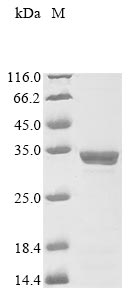The process of producing recombinant human metapneumovirus Matrix protein (M) involves several steps beginning with isolating the target gene that corresponding to the 1-254aa of the M protein of HMPV. This gene is cloned into an expression vector with an N-terminal 10xHis-tag gene and C-terminal Myc-tag gene and then introduced into baculovirus cells through transfection. The baculovirus cells express the protein, which is harvested from the cell lysate. The protein is purified using affinity chromatography. Finally, the recombinant HMPV M protein's purity is determined by SDS-PAGE, reaching up to 85%.
The HMPV M protein plays a crucial role in viral assembly and immune response modulation. Structural analysis has revealed that the HMPV M protein is a key regulator of viral assembly [1]. The M protein of HMPV induces the maturation of antigen-presenting cells, contributing to the immune response [2]. The presence of the HMPV M protein has been detected in bronchiolar epithelial cells during HMPV infection, indicating its involvement in viral replication [3].
Studies have shown that virus-like particles (VLPs) containing the HMPV M protein can induce protective B and T cell responses, highlighting its importance in vaccine development [4]. The HMPV M protein has been utilized as a structural scaffold in the development of VLP-based vaccines, demonstrating its significance in vaccine design [5]. Furthermore, the HMPV Matrix protein has been studied in the context of viral morphogenesis, where it is involved in the formation of higher-order cellular assemblies and virion production [6][7].
References:
[1] G. Amarasinghe and R. Dutch, A calcium-fortified viral matrix protein, Structure, vol. 22, no. 1, p. 5-7, 2014. https://doi.org/10.1016/j.str.2013.12.008
[2] L. Aerts, C. Rhéaume, J. Carbonneau, S. Lavigne, C. Couture, M. Hamelinet al., Adjuvant effect of the human metapneumovirus (hmpv) matrix protein in hmpv subunit vaccines, Journal of General Virology, vol. 96, no. 4, p. 767-774, 2015. https://doi.org/10.1099/vir.0.000031
[3] G. Boivin, G. Serres, M. Hamelin, S. Côté, M. Argouin, G. Tremblayet al., An outbreak of severe respiratory tract infection due to human metapneumovirus in a long-term care facility, Clinical Infectious Diseases, vol. 44, no. 9, p. 1152-1158, 2007. https://doi.org/10.1086/513204
[4] R. Cox, J. Erickson, A. Hastings, J. Becker, M. Johnson, R. Cravenet al., Human metapneumovirus virus-like particles induce protective b and t cell responses in a mouse model, Journal of Virology, vol. 88, no. 11, p. 6368-6379, 2014. https://doi.org/10.1128/jvi.00332-14
[5] V. Cimica, H. Boigard, B. Bhatia, J. Fallon, A. Alimova, P. Gottliebet al., Novel respiratory syncytial virus-like particle vaccine composed of the postfusion and prefusion conformations of the f glycoprotein, Clinical and Vaccine Immunology, vol. 23, no. 6, p. 451-459, 2016. https://doi.org/10.1128/cvi.00720-15
[6] Y. Sabo, M. Ehrlich, & E. Bacharach, The conserved yagl motif in human metapneumovirus is required for higher-order cellular assemblies of the matrix protein and for virion production, Journal of Virology, vol. 85, no. 13, p. 6594-6609, 2011. https://doi.org/10.1128/jvi.02694-10
[7] M. Jumat, T. Huong, P. Wong, L. Loo, B. Tan, F. Fenwicket al., Imaging analysis of human metapneumovirus-infected cells provides evidence for the involvement of f-actin and the raft-lipid microdomains in virus morphogenesis, Virology Journal, vol. 11, no. 1, 2014. https://doi.org/10.1186/s12985-014-0198-8






